There is a certain word in Brazilian Portuguese, "Adágio".
Adágio means a popular proverb with a message of moral content, they are short and easy to memorize phrases, commonly implemented or applied in different situations. Another word that fits into this category is "ditado", which is a literal translation for saying.
When it comes to Magic: The Gathering, there are several sayings, or adágios, applied by the community. Some are very fun, some are very unpleasant, and some are commonly seen as a constant complaint from the community.
In Pauper, there are recurring sayings, particularly involving Tron's supposed oppression and over-flexibility, and the constant predominance of blue decks in the format. In particular, it is very common for you to read or hear the following sentence coming from a Pauper player:
“Blue decks are taking over Pauper”
- Pauper Player
Since I started dedicating myself to Pauper, in 2014, I've heard this phrase more than a hundred times.
Even though we're only in the second week since Chatterstorm and Sojourner's Companion were banned, one assertion has been recurring since Wizards' announcement: Faeries is the best deck of the format.
It's not a conclusion that took long for the community to make, and it's particularly pretty simple to get to it even before the Pauper Showcase: Dimir Faeries was the only deck able to keep up and serve as a regulator against the two decks that took over the format over the past three months: Storm and Affinity.
So, it was to be imagined that, as the archetype wasn't affected in the last update (a point that I particularly consider a correct move by Wizards of the Coast), the deck would remain at the top, as it was before Modern Horizons II, where it competed for the deck to beat title with Tron and Cascade.
And Faeries has been at the top of the format for a long, long time. And that's exactly why I'm writing this article: to calm the spirits of those who are already considering the format unbalanced after the Pauper Showcase, and at the same time, affirm and explain why I faithfully believe my statement below:
Faeries will almost always be Pauper's best deck
Unless something goes really wrong with the format, and we create a polarized state that it can't overcome, the archetype is likely to always be in the format's best deck spot almost unconditionally, and that's largely due to the composition that decks like Faeries have in competitive formats when they have the right support, regardless of any changes because their base is strong enough to handle any sudden changes.
And do you know why it's so common to see people talking about Pauper being “dominated by blue decks”?
Because these decks were always present at the format.
Casting it with Flashback
First, let's understand what Faeries is and its trajectory in format:
The Faeries is, naturally, a Tempo deck.
Some people today categorize it as a Midrange because the deck has more attrition elements and a higher curve than its previous versions or “pure” Tempo decks, but its entire composition is very flexible and dependent upon the format's context: A Tempo deck in Standard, like Dimir Rogues was last season, is essentially different from an archetype in the same category in Legacy.
I could dig deeper for an older Faeries list, but I believe this list, from 2010, is a good starting point for understanding the archetype because Delver of Secrets didn't yet exist, and cards like Empty the Warrens were still legal.
This list made Top 8 on the Pauper Challenge on September 10th of 2010. The archetype was commonly known as MUC Faeries and contained much more game-prolonging elements and some key pieces of Card Advantage that no longer fit the archetype, such as Mulldrifter, in addition to increasing the Faeries' slots with Pestermite, a card that is virtually non-existent in Pauper today apart from some weird combos with Familiars, Fertile Ground and Ghostly Flicker.
The Top 8 of this event included: Storm, Affinity, Goblins, Dimir Flicker, Orzhov Pestilence, Mono-Green Stompy and two copies of Mono-Blue Faeries.
Then Delver of Secrets arrived and the composition of Pauper's blue decks changed significantly in favor of mana efficiency in its purest version: Gush and Daze became staples, and they composed what would come to be known as Mono Blue Delver, a list that was considered one of the format's main competitors and archetype that you would need to respect if you wanted to play Pauper.
The existence (and efficiency) of the archetype led to the creation of other archetypes that tried to prey on it, such as more efficient versions of Stompy and especially the creation of Kuldotha Boros, a deck that managed to prey on Faeries by making efficient card advantage plays with Glint Hawk and Kor Skyfisher, two cards that presented themselves as a huge threat to small flying creatures.
And then Cloud of Faeries was banned. Not officially because of Mono Blue Faeries, but because other combo decks easily abused the card for infinite loops.
It would be death for Faeries, the community said. It would be too much for the archetype to deal with the absence of the powerful tempo play based on Cloud of Faeries + Spellstutter Sprite on turn 2 to hold the opponent's deck.
That's not what happened. The archetype replaced Cloud of Faeries with the not-so-effective but very useful Faerie Miscreant and continued to make good results, only not becoming the best deck at the time because, shortly thereafter, Peregrine Drake was released, and Izzet Drake would dominate the format for months before its fateful emergency ban.
Then came Modern Masters 2017, which brought with it many cards that have become essential to Pauper. In particular, Burning-Tree Emissary, which leveraged Stompy's explosive potential, throwing Faeries' natural predator straight to the top.
Also, around this time, Palace Sentinels was released in Magic Online, leveraging the potential of a deck already well-known at the time as another natural predator of the archetype and giving rise to Boros Monarch, an archetype known to this day.
With these two decks' ascension, it was believed they should push Faeries to rock bottom, making it a Tier 2 that couldn't compete with the current best decks in the format. But the deck has transformed, adapted, adopted new cards and made great use of the card that was also released in Modern Masters 2017, Augur of Bolas, as well as adopting a new manabase and a splash.
The deck could no longer rely on bounce spells to resolve problematic permanents, so it splashed red to add removals that interacted very well against these archetypes: Lightning Bolt would kill several Stompy creatures if they weren't strengthened somehow, while also dealing with Kor Skyfisher. Skred allowed the archetype to deal with any permanent in longer games, killing Palace Sentinels or any other creature for just one mana.
The addition of a new color may have made the archetype slower, but it gave it the possibility to extend games and maintain more favorable exchanges, allowing it to work around the most diverse situations that faster decks or decks with predatory threats to the archetype could deal, an element we see to this day.
While it's not the Faerie-based deck I'm debating in this article, it's important to highlight this format's moment primarily because it preceded Blue Monday, the day that Gush, Daze and Gitaxian Probe were banned, and secondly because it was the moment when Blue-Based decks went from regulators to oppressors.
Foil's arrival at Pauper via an Ultimate Masters downshift made the Blue-Based Decks the absolute best decks in the format by a significant margin. In particular, Dimir Delver stood out because this inclusion allowed, along with the deck's free spells base, that it essentially play as a Legacy deck, where it had its own version of Force of Will, which interacted very well with free spells and still allowed the archetype to calmly play threats like Gurmag Angler in the first turns with backup.
This led, after years of differing opinions about the predominance of blue decks due to the inclusion of Gush, a card banned from every other competitive format, to the banning of the blue free spells category, which significantly weakened Dimir Delver, a deck that seeks to take advantage of as much mana efficiency as possible, but that didn't hurt Izzet Faeries as much, as its list was already moving towards dealing with longer games and using mana efficiently for their interactions (for example, the Faeries lists no longer used as many, if any, copies of Daze).
Later, Modern Horizons brought Arcum's Astrolabe, a card that is currently banned from virtually every competitive format as well, and that pretty much warped Pauper around itself.
Among the Astrolabe decks, Jeskai is the deck that really stood out and technically became a polarizer in the Metagame as its interactions were significantly efficient, and its disruption package was essentially the same as Faeries, but without having to go around as many laps with tribal synergies and Ninja of the Deep Hours bounces, making it a better deck than Faeries in all categories.
Ultimately, Arcum’s Astrolabe was banned and Pauper returned to its natural state where the spot for best deck was disputed between Faeries, Tron, Monarch and decks that tried to play under.
For months, the format remained in this pattern, the archetype went through small evolutions to keep up, such as the adoption of Monarch cards to get more card advantage in a format increasingly focused on attrition games and efficient resources exchanges, and the addition of Cast Down in Double Masters leveraged a version of the archetype that already showed up with occasional results, and is now considered the best Faeries version of the format: The Dimir Faeries.
What Dimir Faeries have that other versions don't is the ability to use Snuff Out, one of the most effective free spells in the format, and which has received a sudden rise in the Metagame along with Black-Based Decks being no longer present in the format, while the Tempo archetypes needed to resort to some mana efficiency to accompany the Midranges and Controls' card advantage, while also taking advantage of the card to hold back the explosion of Aggro decks.
Cast Down just gave the archetype the unconditional slot that allows it to deal with virtually any threat that doesn't call itself Guardian of the Guildpact, making it much more efficient at dealing with resolved threats and leaving out the need to separate your removals slots between cards like Agony Warp, Echoing Decay, among others (although these cards are still used if the Metagame demands it).
The addition of black also gave it two essential elements: A constant card advantage engine that can play against Monarch decks with Thorn of the Black Rose, and a threat that ends the game quickly on an empty board and that was difficult to remove, with Gurmag Angler.
The curious fact is that all the pieces were there, but they had never been efficiently built before, or the Metagame wasn't prone enough for this idea to succeed.
Then came Commander Legends, which brought Fall from Favor.

I'll just say that Fall from Favor was too broken for Pauper, to the point where decks like Affinity are adding the card to their lists, and decks like Mardu Monarch are splashing blue just to add Fall from Favor.
The card was quickly banned from the format, months had passed for a relatively well-balanced Metagame, but with Dimir Faeries always being considered the most efficient deck. Kaldheim brought the snow duals that brought several experiments to the Faeries variants, Strixhaven brought Behold the Multiverse, and we came to Modern Horizons II where, as we know from the recent past, Storm and Affinity broke the format in half... And the only decks able to consistently hold both archetypes were Dimir Delver and Dimir Faeries
Recently, Chatterstorm and Sojourner's Companion were banned, and the Pauper Showcase took place.
The composition of the archetypes that the competitors used in the event was as follows:
33 Dimir Faeries
27 Affinity
12 Izzet Faeries
11 Bogles
7 Tron
5 Boros Bully
5 Jund Cascade
5 Gruul Cascade
4 Moggwarts
3 Mono-Black Control
3 Dimir Delver
3 Burn
3 Walls
2 Jeskai Ephemerate
2 Azorius Familiars
2 Mono Blue Delver
2 Elves
2 Boros Monarch
On the Top 16, we had:
4 Dimir Faeries
3 Affinity
2 Izzet Faeries
2 Moggwarts
1 Jeskai Ephemerate
1 Bogles
1 Azorius Familiars
1 Boros Bully
1 Mono Blue Delver
And its Top 8 was:
4 Dimir Faeries
1 Jeskai Ephemerate
1 Bogles
1 Affinity
1 Moggwarts
I believe the archetype's conversion rate is as expected given the amount of Dimir Faeries present at the event. Actually, except for Moggwarts, which in my view had a result well above the expected average, the conversion of the decks to the Top 16 seems reasonable to me.
But it is undeniable not to mention that, both in popular sayings and in results, Faeries can be considered the best deck in the format today.
And that's where we are now. And now that we've looked at the archetype's trajectory, we need to understand why Faeries is so close to ubiquitous Pauper's tier 1 decks.
Why Faeries will always be the best deck
I have a very recurrent statement I often make when commenting on competitive formats where blue is a predominant or rising color: Tempo Decks are always likely to become the best deck of their formats if they have the right support, as they act as regulators.
Normally, Tempo decks compete for the regulator's space against Midrange decks because they both have elements that give them the flexibility to handle the most diverse situations in a game, but they have a crucial difference between them:
Fo example, Midrange decks are good at handling a variety of situations, but they don't handle any of them exceptionally.
A Midrange deck can be built to handle a metagame where there is a good balance between Aggro, Control and Combo. But its pieces don't usually fit universally in every game, and a removal in your hand will be useless against a Control deck, while a discard from the topdeck will be useless against an Aggro deck.
Meanwhile, Tempo decks are exceptional at handling many situations, and awful at handling a few.
For example, a Tempo deck, in a general context, is always on top of the efficiency of their universal answers. The best example of this is a card widely used in Pauper and Modern, Counterspell.
Counterspell is a good card to have on hand almost every time, and a good topdeck if your board position isn't unfavorable because it offers an unconditional trade, regardless of your opponent's resource.
Where Tempo decks lose out, however, is when their responses become less effective, something that usually occurs when a game gets too long. A Daze in early game or against decks with a greedy curve is one of the best cards the deck could want, but a Daze in late-game is one of the worst topdecks you can imagine.
But for a few years now, Tempo Decks has seemed to be moving less into the spectrum of using responses that lose value as the game progresses: Although Daze is a major Legacy staple to this day, we can see archetypes of other formats opting for answers that manage to be good at most stages of the game.
Take Modern's Izzet Tempo as an example: Cards like Unholy Heat hardly ever lose their usefulness. On the contrary, they get even better as the game progresses under the right conditions, and they have a flexibility in mana and utilities that hardly make the card useless.
Therefore, Tempo decks tend to be bad only if the decks they are playing against exploit their natural weaknesses. Like, for example, playing more cards and putting more pressure than what the deck proposes to trade (like Elves), or being out of the deck's "control" curve, or playing so many explosive threats that any of them who stays in play will become a major threat (like Cascade), or any piece that significantly limits the number of spells and effects the deck can cast (although they're not Pauper cards, I can name Thalia, Guardian of Thraben or Chalice of the Void as examples).
On the other hand, Midranges tend to prey on Tempo decks because their disruptions tend to be quite efficient against the few threats that the archetype usually has, which would be the reason why Dimir Delver is a deck that tends to be low at Pauper lately, and Delver of Secrets itself has become somewhat obsolete for the mere reason of dying to pretty much every used removal currently without generating any value.
But, in the format's regulator spot, Tempo decks tend to succeed in place of Midrange decks because they have... Well, this:

As a Delver decks and Tempo decks admirer, in general, I love talking about Turbo Xerox, and we need to talk about this deckbuilding style in this article:
The Turbo Xerox
Magic: The Gathering is a game based, as I see it, on two key factors: Resources and Variance, and they go hand in hand over the course of a game.
Resources are the cards you use in the game. When you play a card, you are proposing a certain game and a possible exchange of resources with the opponent, or an increase in your resources, and they can be of the most diverse: Life, permanents, lands and, mainly, cards in hand.
And here comes the variance factor: Do you have enough land to use your resources? Are the cards in your hand good enough to make favorable trades? Did your opponent draw a card that made your play from the previous turn totally irrelevant?
All of this is variance, it's how the game behaves and, unlike what people usually say, I don't think these moments are tied to luck, and I commonly see this as an instinctive "excuse" for not analyzing the game's development and accepting that we have some propensities to make bad decisions during a game or even during deck building that tend to punish us in the end result, and taking on this responsibility is very frustrating.
This does not, however, make the variance factor any less crucial to the game: If we look at the deckbuilding process of any competitive deck, they are primarily aimed at mitigating the variance factor. Whether with tutors like in Commander or recurring draw effects like Midranges and Controls do, or with an exponential increase in impactful threats like Modern's Tron or Legacy's Eldrazi Post does, or having access to as many cards as possible with the least amount of mana, as is the case with Turbo Xerox.
I started the article mentioning the meaning of an Adágio, and there is another adágio used in Magic to explain the advantages of Control decks for beginners, which is “The more cards you draw, the more chances you have of winning the game”.
And particularly, the ideal phrase for this logic should be "The more cards in your deck you see and have access to, the more opportunities you will have to win the game."
And that's what Turbo Xerox proposes: Reducing variance with a significant increase in ways to draw cards and manipulate the top of your deck to remove useless cards.
A basic example of this theory, created by Alan Comer in 1998, is that you could reduce one land for every two cantrips you add to the deck, which not only allows for a lower chance of bad topdecks throughout the game, but also enables a certain level of library manipulation when you use them efficiently, which means that every draw you make can be significantly better than your opponent's, creating a virtual advantage in the game.
And this doesn't just apply to lands: Turbo Xerox decks are much easier to find the cards they need because they look at more cards in the deck and at a higher speed than other decks of the format, which allows the archetype to expand its answers. You have more freedom and less punishment by, for example, Splitting Agony Warp and Echoing Decay in your list, as they are cards that face different situations in Pauper, because you have more ways to find them throughout the game or discard them from the top if they are useless through manipulation.
Ultimately, in the big picture, Magic is a game of choices... And what cantrips and other means of library manipulation or accessing more cards does is expand your available choices and maximize the number of decisions you make over the course of a match, giving you more “possible plays".
And because of all these benefits I consider, even after more than two decades since its inception, the Turbo Xerox one of the most efficient and powerful ways to build a deck in Magic: The Gathering, and one that proves efficient to create the best decks in the format whenever there is a solid enough base for it.
Izzet Delver at Legacy, Izzet Tempo at Modern and... Dimir Faeries at Pauper.
Turbo Xerox and Faeries
When we talk about Turbo Xerox decks, we usually have the conception of decks like Izzet Delver from Legacy, which varies from 12 to 16 creatures, a handful of counters, removals and many cantrips, and when we analyze Dimir Faeries, we see a deck that people would commonly classify as a Midrange, especially because its curve is more geared towards longer games, where the essence of Tempo decks tends to be to unbalance your opponent long enough to advance your game plan and win quickly.
The first common mistake in this matter is that times have changed. You just have to think about the individual quality of the recently released cards over the last ten years. The creatures that make up Izzet Delver today, for example, are creatures that do much more than just put pressure on the board. And Faeries, despite being a deck that has had the same creatures base for over ten years, follows this same trend.

Faerie Seer, while not drawing a card, works with the same nature as any cantrip in allowing library manipulation, commonly interacting very well with Brainstorm or Ponder.
Augur of Bolas is a 1/3 body with acantrip for two mana, and it also interacts well with removing unwanted cards from the top while allowing you to “dig” deeper after an answer and remove unwanted cards from the top while holds the opponents' aggressive turns in the early game.

I believe Spellstutter Sprite and Ninja of the Deep Hours deserve a mention of their own in this category because they are the core of the deck, literally the main reason these decks can take any damage or banning at the format and still, the archetype will remain among the main competitors.
Spellstutter Sprite is the pillar of Faeries. The foundation that sustains and gives reason to its core and that makes the Faeries what it is. The deck probably wouldn't be good or wouldn't exist without it.
At worst, Spellstutter Sprite is a pseudo-Snapcaster Mage for Mental Misstep.
With another faerie in play, Spellstutter Sprite will be a pseudo-Snapcaster Mage for Prohibit without paying the Flashback cost. And the score only gets better if you increase the number of faeries each turn.
Added to the fact that Pauper is not a format that usually plays with a very high curve, and even decks like Cascade have low-cost cards that can be answered with Spellstutter Sprite, makes it a staple and a card you need to respect.
I confess that, before Daze's banning, which increased Spellstutter Sprite's efficiency a bit (since playing “above the curve” made your deck more susceptible to Daze), and before Commander Legends brought Boarding Party and Annoyed Altisaur, I considered that the faerie was at a power level above what the Pauper proposes.
And, to this day, I wonder if Spellstutter Sprite is not, in fact, above what the format proposes. After all, she is a Snapcaster Mage for counterspells. On the other hand, I like the spot Faeries has for Pauper these days and consider it too early to consider whether something deserves to be on the banlist or not.

If Spellstutter Sprite is our Snapcaster Mage, Ninja of the Deep Hours is a weird mix of Restoration Angel with, for lack of a better example coming to mind on at the time of writing this article, a heavily nerfed version of Ragavan, Nimble Pilferer.
Yes, I know comparing you to Ragavan is hyperbole, so keep your pitchforks down, what I'm trying to exemplify is how these cards take the game for themselves the moment they enter the board: They demand immediate asnwers, create so much advantage if they damage the opponent more than once, often taking the game on their own, and benefit greatly from the efficient use of your counters and removals and are fragile to blockers.
The crucial difference is that Ragavan, Nimble Pilferer runs on its own and needs literally no setup or virtually no deckbuilding concessions to be great, while Ninja of the Deep Hours depends on efficient setup and a deckbuilding made to abuse its ability to be half what Ragavan is, as a 2/2 creature for four mana that has no immediate impact is a pretty bad card by any format standards.
So, Faeries has the same number of counterspells and cantrips that a Turbo Xerox would normally have, but coupled to creatures because Pauper is a format where the combination of creatures is as important as their individual value.
Now add the following elements to this base:

Cards that are very efficient for Pauper's Metagame, and mainly work to cover the significant disadvantages the deck has against other archetypes, in particular, to keep up with Midranges' card advantage with Thorn of the Black Rose and the lack of an efficient clock with Gurmag Angler.

I've already mentioned above how powerful an efficient cantrip package is. And the archetype uses the best cantrip package ever in competitive Magic.

And finally, the best, most comprehensive, and most efficient generic response available in the format, the best unconditional removal, and the only high-impact free spell left in Pauper.
With this package being the “essence” of the deck, the rest can be adapted to the player's taste, which means that the archetype has infinite possibilities to adapt to any Metagame.
If you expect to face more Affinity and decks with big creatures, you can increase the number of Snuff Out and Cast Down.
If you expect to face more decks that populate the board like Elves or Boros Bully, you have Suffocating Fumes and Echoing Decay.
If you hope to face Guardian of the Guildpact and other difficult to remove threats by traditional means, you have Chainer's Edict, Agony Warp, and Diabolic Edict.
If you expect to face more Cascade decks, you have Lose Focus.
If black-based removals go bad or a rise of blue decks comes up, you can always switch to the Izzet version to get access to Pyroblast or removals like Skred, Flame Slash and Lightning Bolt, and essentially losing nothing from its base because the black pieces are relatively replaceable.
This versatility means that the Faeries can always adapt to any Metagame, no matter what it is.
It was this versatility that made the archetype the only one capable of playing on an equal footing with the two decks that broke the format upon the release of Modern Horizons II, and Faeries still benefited from this because, with fewer decks present in the format, the less spacious the answers need to be, which allows the deck to devote as many slots as possible to fighting oppressive decks.
Therefore, Faeries will always be the best deck on Pauper, and will only lose this position when the format is in a polarized state, or when a broken deck comes up, or when a more efficient Tempo deck takes its place (which, according to the preceding Dimir Delver pre-Blue Monday and Jeskai Astrolabe, will also indicate a polarized format), or if one of its essential cards like Spellstutter Sprite are banned one day.
And I don't think it's necessary at present to intervene directly in the archetype, as it is realizing its common nature within the Metagame, performing the movement we've seen from this category of archetype in essentially almost every competitive eternal format.
What it means to be a "Best Deck"?
The “best deck” is the deck that moves the Metagame in a competitive format. Commonly, it will be a deck that has a positive or even winrate against a large portion of the format, so the deck tends to be more representative in events because it is the safe choice or merely the best possible choice for trying to win an event.
And there can be two types of "best deck" in a competitive format:
The first best deck is the archetype that has a significantly higher power level than the rest of the format, making it polarized around a single deck and pushing out of the format any deck that can't play well against it. A recent example of this deck on Pauper was Storm, which led to Chatterstorm's recent ban.
The other best deck is the archetype that serves as the "fun police" of the format, the deck that has a balanced winrate against the other decks because it has the right elements for it, whether playing under them or having the right answers for each situation, creating a strategy that can watch over and keep in check strategies that would commonly become unfair in its absence.
These decks promote and essentially force interactive games by punishing the opponent for focusing too much on their gameplan and forcing the other decks to also have means to interact, or be punished by the more interactive deck, and commonly their permanence at the top tends to symbolize a healthy metagame.
Faeries is this second type of deck. And I, personally, consider it a good deck to have at the top of a competitive format.
That doesn't mean that Faeries will always be “fair” as the best deck, as new cards can easily make the “fun police” the format's oppressor. That's why cards like Treasure Cruise, Gush and Fall from Favor are banned.
But I don't see, at the moment, the archetype occupying the space of an oppressive deck.
Conclusion
And I end here the explanation of why Faeries is and probably will remain as Pauper's best deck, something that I don't particularly consider a bad thing to the format.
Actually, there's an entire section where I talk about what can be done to defeat Faeries on Pauper. But as this article is already too long, I'm going to delve deeper into this subject in another article, and you can look forward to seeing it soon!
What we need to assess, and it is too early to assess directly, is the format's diversity factor: Pauper has, in its recent past, been in the worst state of its entire existence, with only three decks being competitively viable. And we now need to assess what the diversity of archetypes will look like in the coming weeks.
I predict that Faeries will be at the top in the next Challenges, and I don't expect that, adding all their variants, these numbers will be below 30%, and we will need to analyze what the other 70% of the format will be like, and if the difference between this archetype and the others in representation will not be too wide.
There is still a lot to look at in the coming weeks before we draw conclusions about the predominance or not of one or two archetypes in the format, and let's consider these numbers calmly before we fall into the next eternal looping of asking for a ban.
Thanks for reading!













— Comments 0
, Reactions 1
Be the first to comment